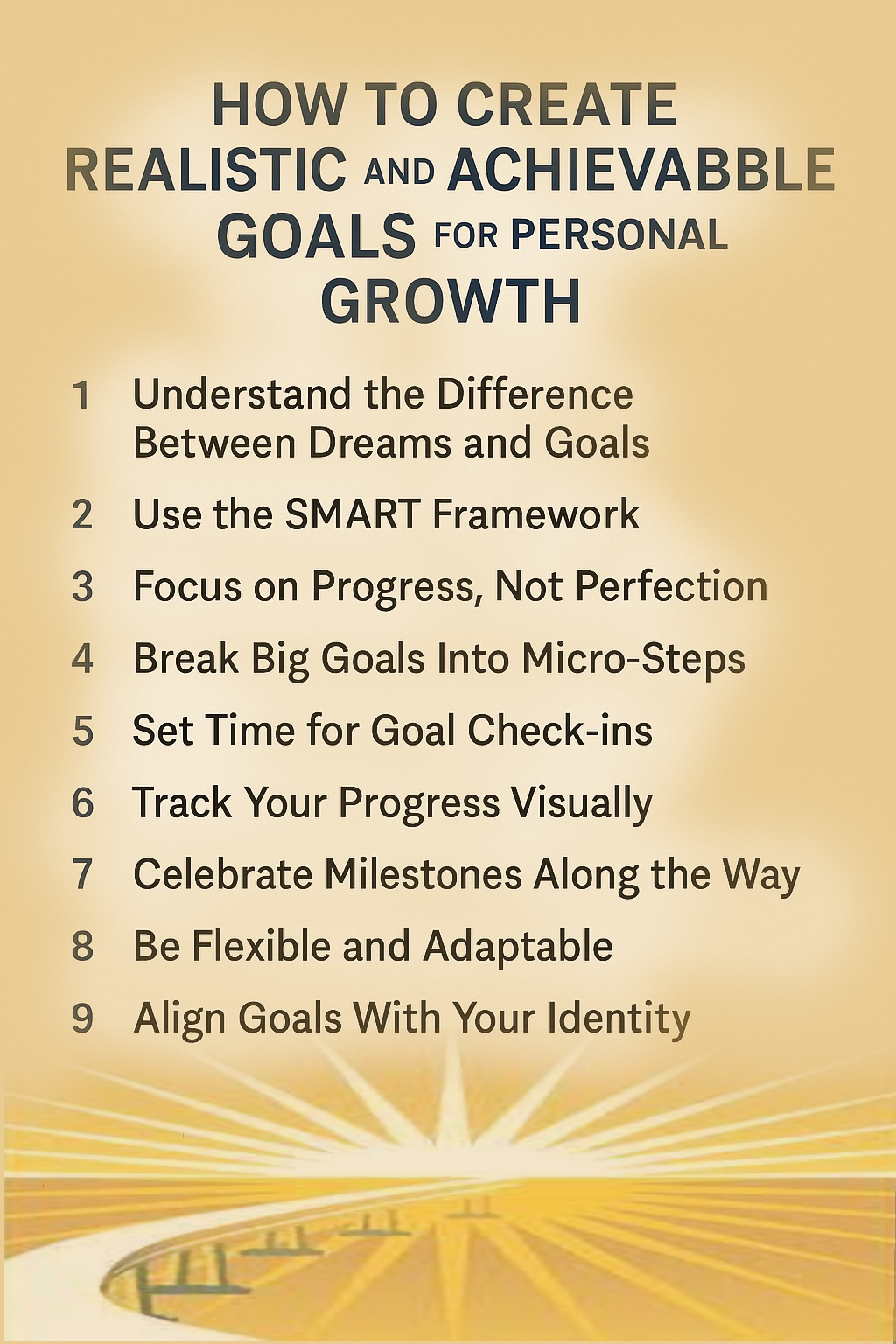Setting goals is one of the most powerful tools for personal development. But there’s a common trap many people fall into: setting vague, unrealistic, or overwhelming goals that quickly lead to frustration and burnout. If you’ve ever given up on your resolutions a few weeks in, you’re not alone.
The key to lasting change isn’t just setting goals — it’s setting the right goals.
In this article, you’ll learn how to create realistic and achievable goals that actually help you grow. You’ll discover simple strategies that keep you motivated, focused, and on track, even when life gets busy.
Why Goal Setting Is Essential for Personal Growth
Goals give your growth direction. Without them, you might feel like you’re busy all the time but not actually moving forward.
Benefits of clear goals:
- They provide structure and purpose
- They help you prioritize your time
- They give you motivation to keep going
- They create a sense of achievement and momentum
But not just any goals will do. They need to be clear, manageable, and aligned with your values.
Step 1: Understand the Difference Between Dreams and Goals
Dreams are the big-picture visions:
- “I want to be more confident”
- “I want to live a healthier life”
- “I want to have financial freedom”
These are great for inspiration — but they’re not actionable on their own.
Goals are what break those dreams down into practical steps:
- “I will journal for 5 minutes each morning to build confidence.”
- “I will walk for 30 minutes, 3 times per week.”
- “I will save $50 from every paycheck.”
Start by identifying your dream, then break it down into specific goals.
Step 2: Use the SMART Framework
The SMART method is a proven way to turn vague intentions into clear, realistic plans.
SMART stands for:
- S – Specific: What exactly do you want to achieve?
- M – Measurable: How will you track progress?
- A – Achievable: Is this goal realistic for your current situation?
- R – Relevant: Does this align with your values and priorities?
- T – Time-bound: When will you complete it?
Example:
❌ Vague goal: “I want to read more.”
✅ SMART goal: “I will read 10 pages of a nonfiction book every weekday for the next 30 days.”
Step 3: Focus on Progress, Not Perfection
A major reason people abandon their goals is because they expect perfect results. But real growth is messy. It involves setbacks, slow days, and unexpected challenges.
Remember:
- A missed day doesn’t mean failure
- Slow progress is still progress
- Consistency > intensity
Celebrate every step forward, no matter how small.
Step 4: Break Big Goals Into Micro-Steps
Big goals can feel overwhelming, especially if you’re trying to balance them with work, family, or personal responsibilities. The solution? Break them down.
Let’s say your goal is to start a side business. Break it into:
- Choose a business idea
- Research your market
- Create a basic plan
- Set up a simple website
- Post your first product or service
Each of these becomes its own mini-goal, making the overall objective feel doable.
Step 5: Set Time for Goal Check-ins
Most people set goals and never revisit them. Don’t make that mistake.
Weekly or biweekly check-ins keep you aligned and give you a chance to adjust when needed.
Ask yourself:
- What went well this week?
- What challenged me?
- What’s one small adjustment I can make?
- Am I still on track — or do I need to revise the goal?
Check-ins keep your goals alive and evolving with your life.
Step 6: Track Your Progress Visually
Seeing your growth helps you stay motivated.
Try:
- A calendar with daily goal streaks
- A habit-tracking app like Streaks or Habitica
- A progress journal
- A printable checklist you can hang in your room
Visual tools reinforce positive behavior and make your effort visible.
Step 7: Celebrate Milestones Along the Way
You don’t have to wait until the goal is complete to celebrate. Mark your small victories — they keep your momentum going.
Examples:
- Treat yourself to something meaningful
- Share your progress with a friend
- Take a relaxing break or short trip
- Reflect on what you’ve learned so far
Celebration is not indulgence — it’s motivation.
Step 8: Be Flexible and Adaptable
Sometimes, life changes. You may face obstacles, or your priorities might shift. That doesn’t mean the goal has failed — it means you need to adapt.
Ask:
- Does this goal still align with who I’m becoming?
- Do I need to change the timeline?
- Is there a better path forward?
Adaptation is strength, not weakness.
Step 9: Align Goals With Your Identity
The most powerful goals are the ones that shape your identity. Instead of just focusing on what you want to do, think about who you want to become.
Examples:
- Goal: “Write 500 words a day.”
Identity: “I’m a writer.” - Goal: “Exercise 4 days a week.”
Identity: “I’m someone who prioritizes my health.”
When your actions align with who you believe you are, discipline becomes easier.
Final Thoughts: Make Goal-Setting a Lifestyle
Creating realistic and achievable goals is not just a one-time task — it’s a lifestyle shift. It’s about deciding that you’re worth the effort, the time, and the patience required to become the person you want to be.
Start with one goal this week. Make it SMART. Break it down. Track your progress. And most of all, be kind to yourself along the way.
Because growth isn’t about being perfect.
It’s about being committed.
